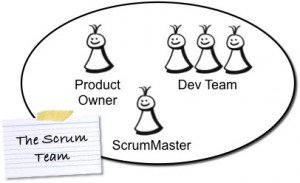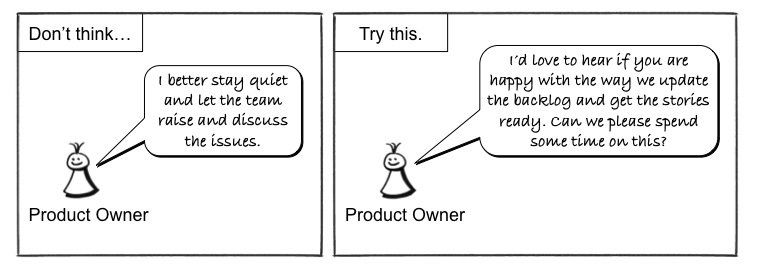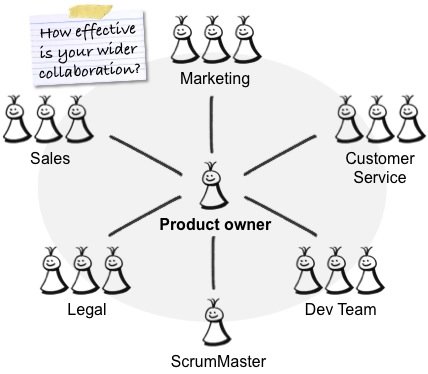The Product Owner’s Guide to the Sprint Retrospective
Summary
The sprint retrospective is the key mechanism in Scrum to improve the way people work. Some product owners believe though that they should not attend the meeting, and if they do then only as guests and not as active participants. But the retrospective does not only benefit the development team and the ScrumMaster; it is also an opportunity for the product owner to learn and improve, as this post explains.
The Retrospective in a Nutshell
The sprint retrospective is an opportunity to pause for a short while and reflect on what happened in the sprint. This allows the attendees to improve their collaboration and their work practices to get even better at creating a great product.
The meeting takes place right at the end of the sprint after the sprint review meeting. Its outcome should be actionable improvement measures. These can range from making a firm commitment to start and end future meetings on time to bigger process changes. The retrospective is not a finger-pointing exercise. As Mahatma Gandhi famously said: “Be the change you want to see in the world.”
Take Part
As the product owner, you are a member of the Scrum team, which also includes the development team and the ScrumMaster. While you are in charge of the product, you rely on the collaboration of the other Scrum team members to create a successful software product. If you don’t attend the retrospective as the product owner, you waste the opportunity to strengthen the relationship and to improve the collaboration with them.
But there is more to: Taking part in the sprint retrospective allows you to understand why the team requires some time in the next sprint to carry out improvements such as refactoring the build script, or investigating a new test tool; and maybe more importantly, it helps you improve your own work.
Say that some of the user stories the team had worked on did not get finished in the sprint. At first sight this looks like the development team’s fault. But analysing the issue may well reveal that the size of the stories and the quality of the acceptance criteria contributed to the problem. As you are responsible for ensuring that the product backlog is ready, this finding affects your work: It shows you that you have to decompose the user stories further and it suggests that the development team’s involvement in getting the stories ready should be improved – otherwise you would have spotted the issue before the stories went into the sprint.
If you had not been in the retrospective would you then whole-heartedly support the resulting improvement measures and change the way you work?
Be an Active Participant
Don’t attend the retrospective as a guest who will speak when asked but otherwise remains silent. Be an active participant, use the sprint retrospective to get feedback on your work, and raise any issues that you want to see improved. Be constructive and collaborative but don’t shy away from tough problems.
Here are some questions that you may want to explore in the retrospective:
- Do you spend enough time with the development team? Are you available to answer questions or provide feedback quickly enough? Do you provide the right level of feedback and guidance in the right way?
- Is the communication between the team and you open, honest, and trustful?
- Does the team know how the users employ the product?
- Are the team members happy with their involvement in analysing user feedback and data, changing the product backlog, and getting stories ready for the sprint? Do you get enough support from the team to “groom” the backlog?
- Are the team members aware of the big picture – the overall vision, the product strategy, and the product roadmap? Do you get enough of the team members’ time to help you with product planning and product roadmapping?
Improve the Wider Collaboration
As important as it is, continuously improving your collaboration with the development team and the ScrumMaster is usually not enough. You also need strong relationships with all the other people required to make the product a success. These include individuals from marketing, sales, customer service, finance, and legal, as the following picture shows.
A great way to review and improve the collaboration with your partners from marketing, sales and so forth is to invite them to the retrospective on a regular basis. Depending on how closely you collaborate, this may range from once per month to once per major release. A joint retrospective will help you develop closer and more trustful relationships, help smooth the launch of new product versions, and improve selling and servicing the product.
Here are some questions that you may want to explore in an extended retrospective:
- Are the partners from marketing, sales etc. involved enough in the product planning and roadmapping activities?
- Do they regularly participate in the sprint review meetings? Are the review meetings beneficial for them? Do they understand the project progress?
- Do they receive the information necessary to carry out their work in a timely manner, for instance, to prepare the marketing campaign and to compile the sales collateral?
- Do you get enough data and support from the partners, for instance, regular updates on the sales figures and the market feedback you require?
You can, of course, also discuss these questions one-on-one. But getting any issues on the table and discussing improvement opportunities creates a sense of we-are-all-in-this-together; it reaffirms the need for collaboration and teamwork to provide a great product; and it can break down departmental boundaries.
Learn More
You can learn more about the sprint retrospective meeting and the product owner by attending my Certified Scrum Product Owner training course. Please contact me if you want me to teach the course onsite or if you would like me to run a product owner workshop at your office.
| Reference: | The Product Owner’s Guide to the Sprint Retrospective from our JCG partner Roman Pichler at the Pichler’s blog blog. |





